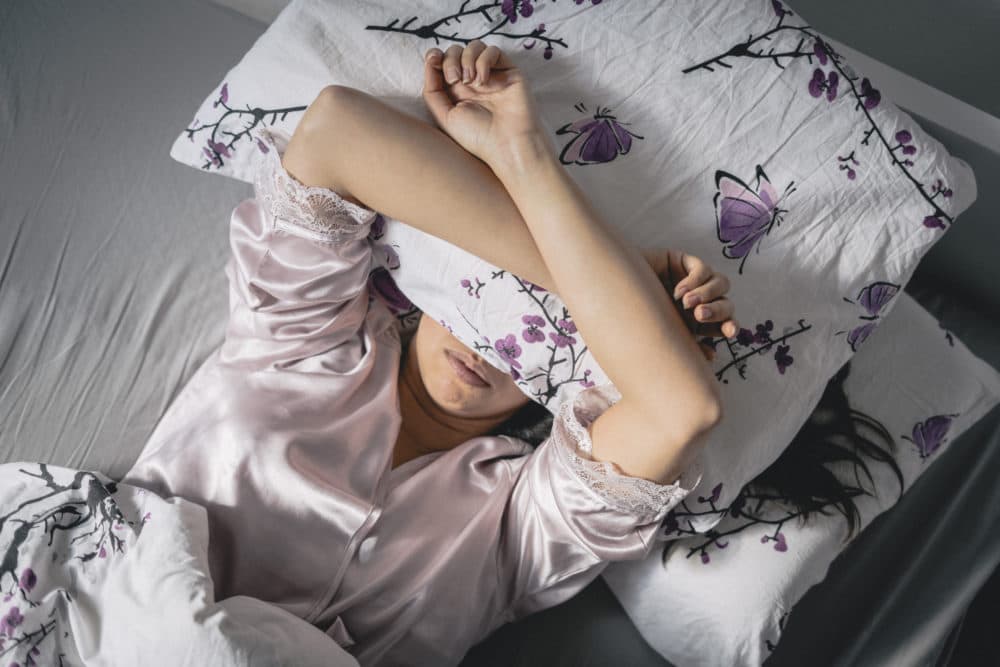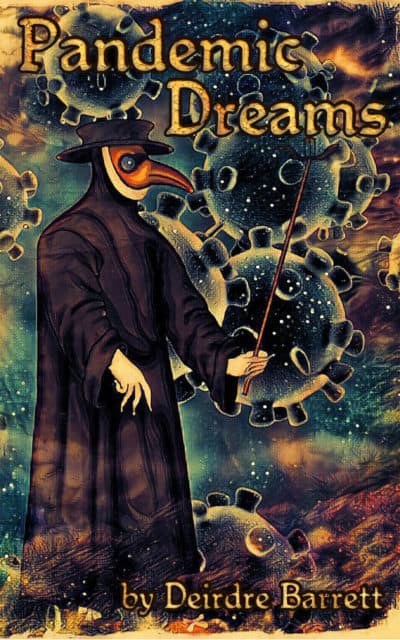Advertisement
It Was All A 'Pandemic Dream': New Book Captures Visions Of Bugs, Whales, Polar Bears
Resume
The combination of a global health crisis and stay-at-home orders creating more time to sleep makes this an extraordinary time in the history of dreaming.
Harvard dream researcher and psychologist Deirdre Barrett makes the case in her new book “Pandemic Dreams,” a collection of vivid COVID-19-related dreams accompanied by her advice for practical exercises to control stress and anxiety while asleep.
Barrett gathered thousands of dreams through an online survey and found many people dreamed about catching the coronavirus, spiking a fever and experiencing shortness of breath.
She also noticed metaphors for COVID-19 popping up in dreams.
“Bug attacks have been a really common cluster of metaphors for the virus,” she says. “I think partly because we use the slang term I'm getting a bug to mean I'm getting a virus.”
People are also envisioning getting far away from it all, she says. One woman Barrett heard from had a post-apocalyptic dream where the North Pole was the only place of refuge from the virus. As she trekked around the tundra, she shot a polar bear during an attack.
“Parenthetically, she says she would never shoot anything, much less an endangered species,” Barrett says. “But she's in this kind of brutal ‘Mad Max’ plus ice kind of setting.”
Others experience dreams of a utopian virus-free world, she says.
In the early pandemic days, many people were dreaming of activities related to COVID-19 such as social distancing or wearing masks, she says. Mid-pandemic, people who were in lockdown alone experienced dreams of being put in solitary confinement or jail. People who were sheltering-in-place with many family members or roommates experienced dreams of overcrowding, she explains.
Recent dreams she’s heard of have encompassed being called back into work before people are comfortable with doing so or dreams of an uncertain future.
Barrett’s favorite story came from a woman who dreamed she stepped out of lockdown for the first time and whales were “swooping through the sky.”
Those who have been traumatized by virus-related visions can use certain techniques in order to stop anxiety-filled dreams before your head hits the pillow.
Barrett says to pick out what your ideal dream would be, whether it be someone you miss or a perfect vacation spot.
“Then as you're falling asleep, you're telling yourself, ‘I want to dream about this.’ Also, form a mental image. Our dreaming mind is so visual,” she says. “It's also a good way to get that request through to your dreaming mind.”
This technique might not work for everyone. Barrett says she conducted a study with college students using the ideal dream method and found 50% of them ended up having the dream they set their mind on.
This approach is similar to incubating a dream, but she says incubation can also be used to solve a particular personal or professional problem, change nightmares or craft a specific mastery outcome.
She also suggests doing a “dream interview,” which you can do alone or with a friend. Pick out the key elements of your dream — the main characters, objects, place — and ask questions about them. As you go through the questions, think about any elements that can tie it together in your real life.
Barrett says she believes in interpreting dreams but lately has heard from many people that they just want the anxiety-ridden nightmares to end and to sleep peacefully again.
“If you don't want to interpret it, just think of what you want to dream about,” she says. “And that will make it much less likely that you have anxiety dreams tonight.”
Book Excerpt: 'Pandemic Dreams'
By Deirdre Barrett
I looked down at my stomach and saw dark blue stripes. I “remembered” these were the first sign of being infected with COVID-19.
My spaceship was supposed to be heading back to earth but it got diverted to Saturn, and I ended up just living there alone.
My home was a COVID-19 test center. People weren’t wearing masks. I’m taken aback because I wasn’t asked to be a test site. I‘m worried that my husband and son (who actually lives out of state) will catch it because of my job as a healthcare worker.

I was a giant antibody. I was so angry about COVID-19 that it gave me superpowers, and I rampaged around attacking all the virus I could find. I woke so energized!
Since the COVID-19 pandemic swept around the world, and we began to shelter-in-place, people have reported unusually active dream lives. We’re remembering more dreams than usual, and those dreams are especially vivid and bizarre. The virus itself is the star of many--literally or in one of its metaphoric guises.
As a dream researcher at Harvard Medical School, I was immediately curious to see what our dream live would tell us about our deepest reactions to this new disaster. I had studied the dreams of 9/11 survivors, of Kuwaitis during the first Gulf War, and dreams from POWs in WWII concentration camps. What pattern from these past crises would we see again? What dream metaphors would be unique to the current pandemic? And most important, how might a better understanding of our collective dream lives help us as we move through this crisis, and beyond In late March, I began to collect dream reports via an online survey. The response to this has been overwhelming. In less than three months, I have already collected more than 9,000 dreams from over 3,700 dreamers, all around the world.
Pandemic Dreams discusses why our dreams have been so vivid since this began, and explores different form the crisis is taking in our dreamlife—characterizing major themes in these dreams and what the symbolize. It offers guidance on how we can best utilize our newly supercharged dream lives to aid us through the crisis and beyond. It explains practical exercises for dream interpretation, reduction of nightmares, and incubation of helpful, problem-solving dreams. It also examines the larger arena of what these collective dreams tell us about our instinctive, unconscious responses to the threat and how we might integrate them for more livable policies through these times.
Many of the book’s generalizations and examples rely on my survey, but it also includes the longer conversations I’ve had with people about their dream during the pandemic and draws on my past crisis dream collections for comparison. The book is divided into five chapters addressing different aspects of pandemic dreams; each ends with a practical exercise you can use with that category of dream.
Action: Reducing anxiety dreams
Try to pose for yourself this task: not to think of a polar bear, and you will see that the cursed thing will come to mind every minute.
-Fyodor Dostoevsky, Winter Notes on Summer Impressions, 1863
Research on ironic process theory, or “the white bear problem,” confirms that deliberate attempts to muffle specific thoughts make them more likely to surface, so it is unproductive to try to suppress anxiety-producing or depressing topics. If you are disturbed by repetitive anxiety dreams, you do not want to expend energy struggling not to have them. The best remedy is to think of what dreams you would enjoy. Perhaps there’s a loved one you can’t be with right now who you’d like to visit with in your dreams? Or a favorite vacation spot? Many people enjoy flying dreams. Maybe you have one all-time favorite dream you’d like to revisit? With what we call “dream incubation,” borrowed from the term used at the ancient Greek dream temples, you can suggest to yourself what you would like to dream as you fall asleep.
Dreams are extremely visual, so an image is especially likely to get through to your dreaming mind. Picture that favorite person, place, or yourself soaring above it all. Or replay that favorite dream in detailed scenes. If images don’t come easily to you, place a photo or other objects related to the topic on your night table as the last thing to view before turning off the light. Repeat to yourself what you want to dream about as you drift off to sleep.
The technique makes for a pleasant experience as you’re falling asleep and greatly raises the odds that your dreaming mind will honor your request.
Excerpted from "Pandemic Dreams" by Deirdre Barrett. Copyright © 2020 by Deirdre Barrett. Republished with permission of Oneiroi Press.
Emiko Tamagawa produced and edited this interview for broadcast with Tinku Ray. Serena McMahon adapted it for the web.
This segment aired on July 9, 2020.

